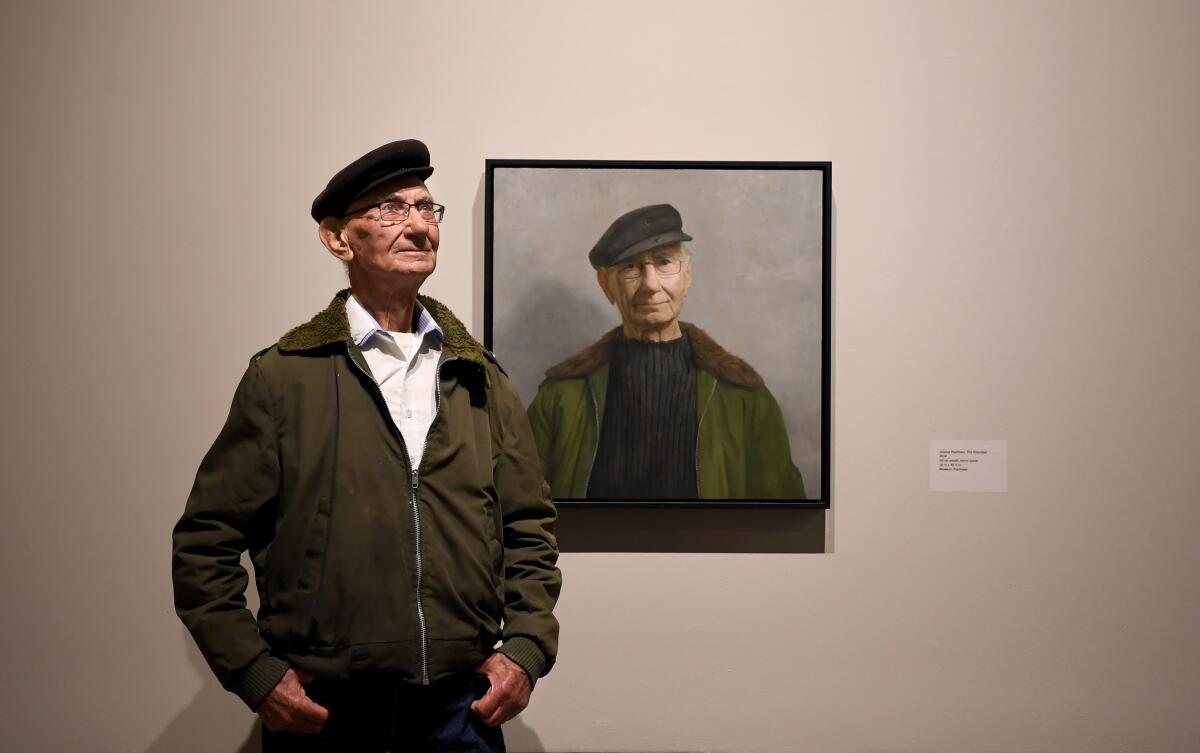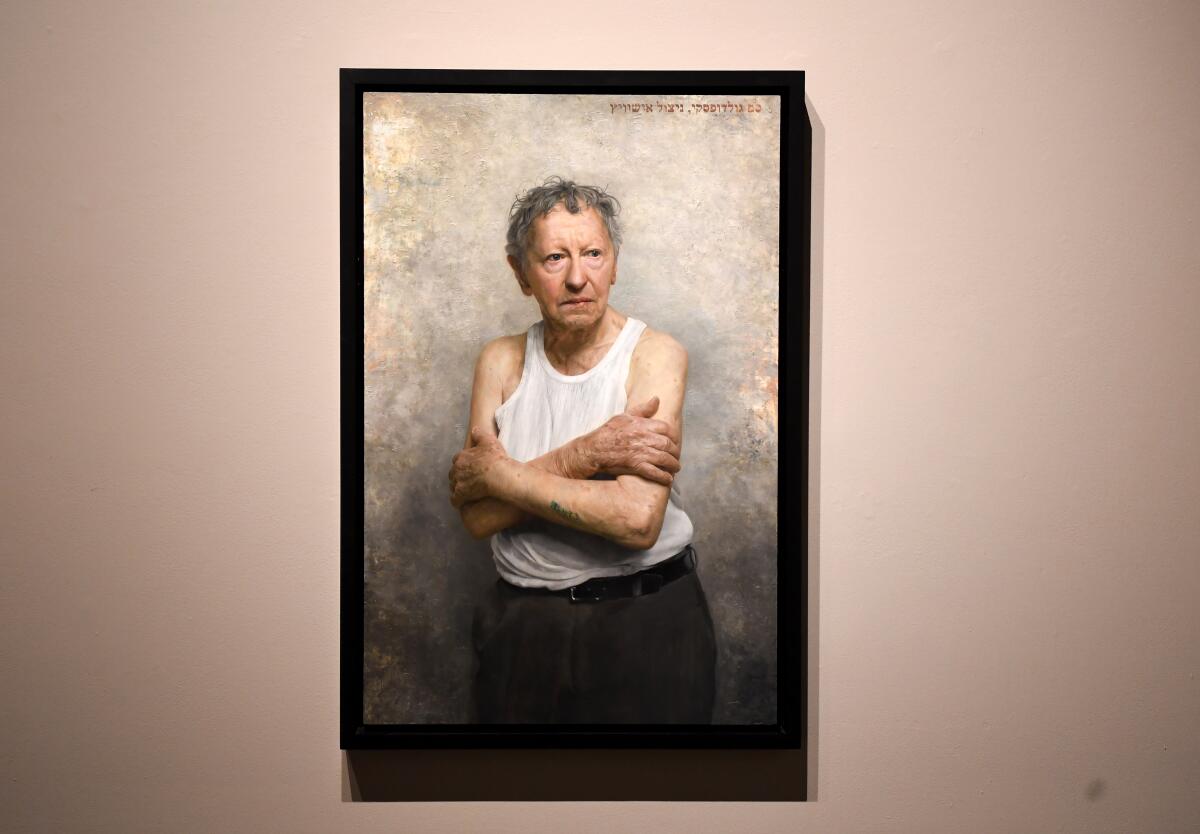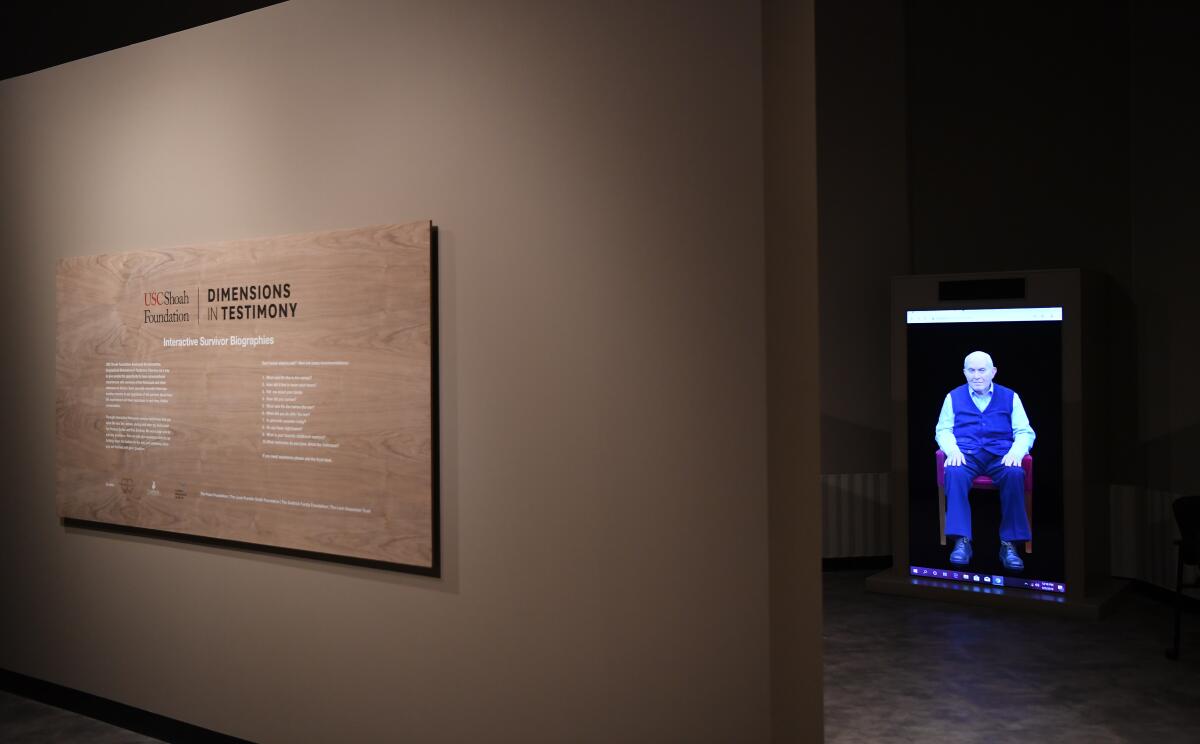Holocaust survivor portraits at USC museum call on ‘profound’ beauty to fight hate
- Share via
Death is not something 91-year-old Joshua Kaufman is afraid of. Not now, after having survived four Nazi concentration camps during World War II. Not even after he’d been ordered, at Dachau, to pile up the weak, injured and nearly dead human beings, his fellow prisoners who had collapsed from forced labor and were to be transported to the crematorium.
A different fear seems to plague Kaufman: forgetting.
“The younger generation, they have to remember,” Kaufman says of the Holocaust, while turning to a newly installed portrait of himself at the USC Fisher Museum of Art. “Those people, they looked up at me and said: ‘If you survive, don’t let them forget us.’”

Kaufman’s portrait, by Albuquerque artist David Kassan, is part of the solo exhibition “Facing Survival,” opening Sept. 18. It includes sketches, charcoal drawings and oil paintings of more than two dozen Holocaust survivors along with their recorded testimonies. Visitors can watch videos, read transcripts, even ask questions of a virtual survivor in an interactive video installation.
The show is co-organized by the Fisher Museum and the USC Shoah Foundation, which was founded by Steven Spielberg and has collected more than 55,000 testimonies from survivors of nine genocides globally. That includes the Holocaust as well as the 1915 Armenian genocide, the 1975 Cambodian genocide and the 1994 genocide against the Tutsi in Rwanda.
“Facing Survival” comes at a critical moment, says Shoah Foundation executive director Stephen D. Smith. The exhibition is one of the foundation’s “Stronger Than Hate” initiatives, a program launched after the 2017 white nationalist march and car attack in Charlottesville, Va., and the rise of anti-Semitism, racism and hate crimes globally.
“We’re in a place I never thought that we would be again,” Smith says. “But because of our archive, we can shine a light on that, provide pathways to counter it and to educate and illuminate. If ever there’s a time that the Shoah Foundation is needed, it’s right now.”
The Kassan exhibition offers “a way of bringing beauty to this conversation,” Smith says.
Testimony — verbal and visual — is the backbone of the exhibition. It’s an integral part of Kassan’s process. The artist, whose work has been shown at the Smithsonian’s National Portrait Gallery and the National Portrait Gallery in London, travels internationally to meet with Holocaust survivors. He conducts lengthy video interviews with his subjects, probing their histories while photographing and sketching them. Occasionally he even arranges for a live audience, turning the investigative process into a piece of documentary theater. He later listens to those interviews, along with recorded testimonies in the Shoah Foundation’s archive, when painting their portraits in his studio.
“Being in their living rooms and getting to know them — it soaks into the painting, it’s a more empathetic eye,” Kassan says. “Paintings are vessels. I want the works to be a history of their lives in layered paint. Because it takes me layers of process — months and years — to do them.”
In January 2017, Kassan interviewed and sketched Kaufman in a friend’s downtown L.A. loft before an audience of about 60 people, many of them art students. It was a fundraiser for the project. “Facing Survival” will include a video installation meshing four of Kassan’s interviews, with five different survivors, all shot and edited by the project’s videographer, Chloe Lee.
That process of “profound investigation,” says Fisher Executive Director Selma Holo, is what makes Kassan’s otherwise traditional portraiture feel so contemporary.
“What David does, in terms of the works themselves, is: He reaches out for technique into distant memory. You can almost feel the Dutch artists, the old ways of incredible traditional realism at his foundation. But his subjects are very much of the now — their dignity now, their pride now. They’re not victims.”

Kassan is Jewish but was raised secular when growing up in Arkansas, Germany and New Jersey as his father was in the Air Force. The artist began his painting project five years ago. Five of his subjects have since died. In 2017 Ojai painter John Nava introduced Kassan to Smith and Holo. They were so taken with what Kassan was doing that they raised money to create what’s now been a two-year artist-in-residence position so that he could complete the project. “Facing Survival” will be Kassan’s first solo museum exhibition.
The oil portraits in the exhibition — most painted on mirrored acrylic panels to give them visual depth and to literally mirror their subjects’ experience — share a dark, cloudy background; but they are also brazenly unsentimental and current, all subjects painted late in life who have defied staggering odds to survive. Each painting will be accompanied by a QR code on the wall so that visitors can access video testimonies from each subject on phones.
One of the works in the show is a five-panel painting of 11 L.A.-based Auschwitz survivors whom Kassan photographed, together, at the Museum of Tolerance in 2017. Visitors can click on an accompanying screen to access brief, or extended, text transcripts of their testimonies.

Also on view in the exhibition is the interactive video installation “Dimensions in Testimony,” which features hologram-like virtual survivors — in this iteration, Pinchas Gutter and Eva Schloss — of whom visitors can ask questions. The installation, which debuted in 2015, has been shown at the United Nations and at museums including the Swedish History Museum in Stockholm this year. This is the first time it’s being shown in L.A.
Just don’t call it a hologram or a work of artificial intelligence, Smith stresses, adding that those digital terms, often used in commercial gaming, might suggest a fictitious avatar. There’s an AI aspect to how the database records visitors’ spoken questions and continually refines answers, essentially becoming smarter, but the AI doesn’t fabricate the content. The onscreen personas in “Dimension in Testimony” are real people who have given up to 20 hours of video interviews to fill the installation’s database with answers to about 1,900 possible questions.
“We don’t want there to be a misperception that these testimonies are made up,” Smith says. “Holocaust deniers have become more sophisticated and tend to engage more in revisionism, where they might question the scale or cast doubt on what occurred, undermining the historical truth.”
It’s been nearly 75 years since the Holocaust ended, but 91-year-old Kaufman — who went on to have a family and still works as a plumber in L.A. — remembers that dark history all too clearly.
He glances, one last time, at his portrait, which the Fisher has purchased for its collection.
Others will remember, now, too.
“This is just the beginning,” Kassan says. “I want to record and document as many survivors as possible. This exhibition is not the end.”
'Facing Survival'
Where: USC Fisher Museum of Art, USC
When: 12- 5 p.m. Tuesday through Friday; 12-4 p.m. Saturday; Sept. 18–Dec. 7.
Info: fisher.usc.edu/davidkassan/
More to Read
The biggest entertainment stories
Get our big stories about Hollywood, film, television, music, arts, culture and more right in your inbox as soon as they publish.
You may occasionally receive promotional content from the Los Angeles Times.











